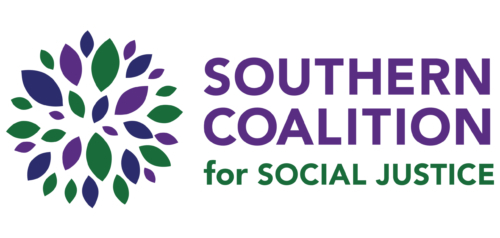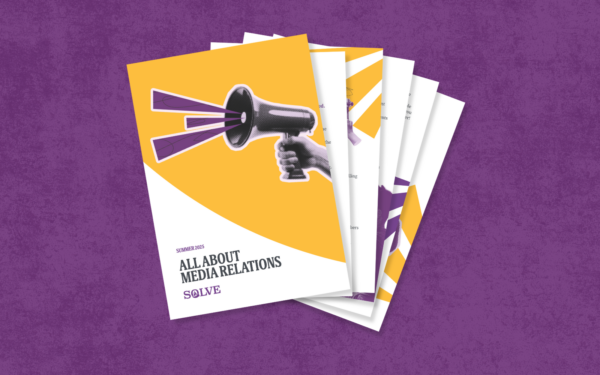All About Media Relations
SOLVE created this digital toolkit to help network members with ongoing communications needs. While each organization will take different approaches, our joint effort in the fight for a participatory, responsive, inclusive, and expansive democracy in the South is the central focus. We hope you find the content in this toolkit both informative and useful.

Steps for effectively communicating your message through the media:
Preparation is key!
Before reaching out to media, know:
- Your message: Use the VPSA (Value, Problem, Solution, Action) method from The Opportunity Agenda to shape a clear, compelling narrative.
- Value – Why should people care? Connect to shared values.
- Problem – Define the issue concisely.
- Solution – Offer a clear, actionable fix.
- (Call to) Action – What’s the next step for your audience?
- Your audience: Tailor your message to resonate with different audiences. How you speak about an issue with community members may be different from communications with elected officials.
- The media outlet: Understand their focus, capacity, and audience.
Tip: Develop a strong talking points document, anticipate questions, and practice staying on message.
With shrinking newsrooms and journalists covering multiple beats (or focus areas), relationship-building is key.
Here are a couple tips to cultivate those relationships:
- Be responsive. Reply promptly and provide all necessary details.
- Make it easy. Share supporting materials and answer the five W’s and H (who, what, when, where, why, and how).
- Do your research. Understand a reporter’s interests to tailor your pitch.
- Reach out on a consistent basis. Taking the time to let a person know what your group’s interests are, upcoming community events or happenings like court or legislative hearings and how you could help with their reporting goes a long way.
- Use a timely hook. Connect your story to current events or deadlines.
You got the interview! This is when we continue to think strategically about how we want our message to be received.
You can prepare by doing the following:
- Designate a spokesperson. Your spokesperson gives the organization a voice and face and aids in building trust with the public.
- Practice potential questions and refine your responses. This is the time to rehearse key talking points to sound approachable and knowledgeable.
- Know when and where to use statistics. While data is important, make the effort to personalize the stats or figures you are sharing.
- An example “Studies show that 90 million eligible voters did not vote in 2024.” vs “Jane Doe is one of the 90 million eligible voters in the country who face unjust and discriminatory barriers to the ballot that keep communities from having equal say in who represents them.”
- Understand media terms: On the record means your words can be quoted; on background means the content can be used but not attributed to you; and off the record means the information provide cannot be attributed to you or your organization nor used in publications. On background and off-the-record can be useful for providing context on sensitive topics, but the default should be to talk on the record whenever possible.
- Stay on message—stick to key points.
- Assume everything is quotable, but you can often ask to restate something for clarity. This is especially helpful for broadcast interviews – the journalist wants the piece to be understandable and clear and is unlikely to object to your restating a point. If you fumble your words for a recorded piece, ask if you can start over! You can also ask for a quote to be read back to you if it is for a print piece.
- Answer questions you want to be asked. It’s okay to pivot in interviews to expand upon your key points from time to time. Make sure you have a few overview comments to explain the scenario from a 10,000foot view that can aid in digressing to the original point.
Your interview is published—now it’s time to share it!
Highlight your media coverage by doing the following:
- Promote across your personal or organization’s social media, newsletters, and website.
- Engage with the article by commenting and tagging key stakeholders.
- Share with partner organizations (including SOLVE) to expand reach.
Communications Methods
- The main function of a press release is to announce important news to the public and ensure key updates get attention.
- Public statements are typically used to respond to external events either while it is happening or afterward. This is going to be a short message with a personal tone from a spokesperson or official.
- Media advisories or media releases are great for inviting members of the media to events like press conferences, media briefings, town halls, etc.
- Op-eds provide an opportunity to give an in-depth opinion piece to share a viewpoint on current issues. A letter to the editor offers a simplified way to express concerns or give insights on a topic or event.

In the wake of Hurricane Helene, Be The Ones issued a clear and timely public statement after the S.C. voter registration deadline was extended. There was a need to share information quickly, given the close timing of the election. Be the Ones decided upon a press release, and SOLVE helped with the creation of the document and sent it out to reporters.
Communication Building Blocks
Talking Points: Serve as the foundation for other communications.
- 3-5 points
- Frames an issue
- Includes a call to action
Statement: A clear way to raise awareness and establish where you or your organization stand on an issue.
- Short, directly to the point
- 2-3 sentences max
- Offers ability to respond quickly to news events
- Ex. Every eligible American deserves the right to vote without unnecessary barriers. We're working to protect access to the ballot and ensure fair elections.
Sound Bite: Your mic drop moment
- 1-2 sentences
- Short, specific and vivid
- Paints a picture
- Think about using metaphors
- Ex. Voting is the heartbeat of our democracy—and we're here to make sure it never skips a beat.
When all else fails, bridge to the next topic and simplify. Bridging allows the spokesperson to answer the question while moving towards the key points in the discussion.
Communications Glossary
Media relations refers to the building and maintaining of relationships with journalists as a way to inform the public about key issues.
On-the-record refers to information or conversations that journalists can include in their articles.
Off-the-record refers to information or conversations you do NOT permit to be featured in an article.
Reporters can still mention “on-background” information in their work, but you will not be quoted or cited as the source.
Press releases are made with the purpose to announce important news to the public and ensure key updates get attention.
Media statements are typically short messages with a personal tone from a spokesperson or an official that is used to respond to external events either while it is happening or afterward. (Keep them short!)
Spokesperson refers to an individual who is selected to speak to the media on behalf of the organization.
Media advisories are used as a method for inviting members of the media to events like press conferences, media briefings, town halls, etc.
Opinions and editorials (Op-eds) are articles that provide an opportunity to give an in-depth opinion piece to share a viewpoint on current issues. Many of these are not behind paywalls but can be an effective way to reach lawmakers and decision makers.
A letter to the editor (LTE) is a letter sent to a publication about an issue of concern to the reader.
Communications Resources
How SOLVE can help you
Excited to get started or need communications support? Review the list of support areas SOLVE can assist your organization with.
- Messaging Guidance & Toolkits: Leaning on tested messaging research, we can help you come up with the right talking points and resources to help speak about complicated issues impacting your state.
- Op-eds & Letters to the Editor: We can help you craft an op-ed, including editing and placement help as well as a letter to the editor strategy to amplify your voice and that of your supporters.
- Press Support: Planning a rally? Have concerns about a pending bill? SOLVE can help you with media strategy by sharing templates, thoughts on approaches, and help guide you through drafts, edits, and sending out to media (dependent on capacity).
- Communications Trainings and Workshops: Looking to strengthen your communications skills? Want to prepare for an interview with media? We offer regular training sessions to empower you and your organization.
- Content Strategy: Want to create engaging content for future programming? We can guide you through ways to develop — and maintain — a strategy that resonates.
Contact information: Contact solve@scsj.org to schedule a time to discuss communications support needs.

